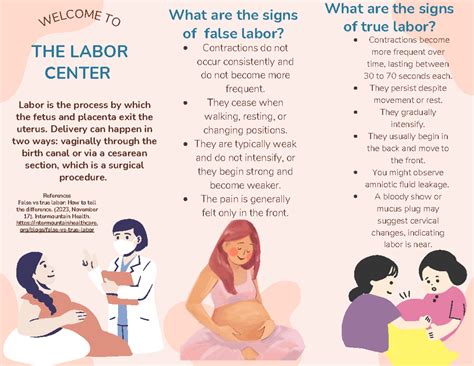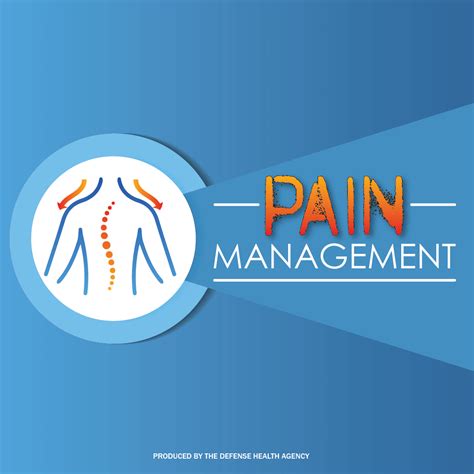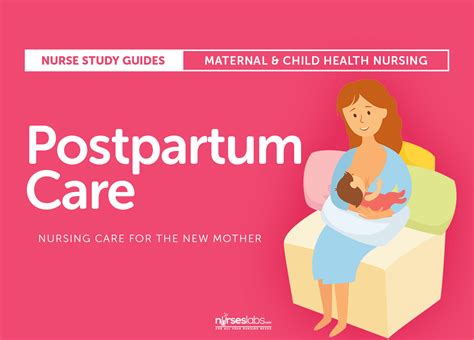Intro
Identify early signs of labor, including contractions, back pain, and bloody show, to prepare for childbirth, understanding labor stages and pregnancy symptoms for a smooth delivery.
As the due date approaches, expectant mothers often wonder when labor will begin and how they will know it's time to head to the hospital. Recognizing the early signs of labor can help women prepare for the birth of their baby and ensure a smooth transition into parenthood. Labor is a unique and individual experience, and the signs can vary from woman to woman. However, there are common indicators that signal the onset of labor, and being aware of these signs can help expectant mothers feel more in control and prepared.
The journey to motherhood is an exciting and life-changing experience, filled with anticipation and uncertainty. As the body prepares for labor, it undergoes a series of physical and emotional changes that can be both fascinating and intimidating. Understanding the early signs of labor can help women navigate this transition with confidence and clarity. Whether it's the first pregnancy or a subsequent one, recognizing the signs of labor can make a significant difference in the overall birth experience.
As the due date draws near, women may start to feel a mix of emotions, from excitement and joy to anxiety and fear. The uncertainty surrounding labor can be overwhelming, but being informed and prepared can help alleviate some of these concerns. By understanding the early signs of labor, women can take control of their birth experience and make informed decisions about their care. From breathing techniques and pain management to hospital procedures and postpartum care, being aware of the signs of labor can help women feel more empowered and confident as they embark on this life-changing journey.
Physical Changes During Early Labor

Another physical change that occurs during early labor is the release of the mucous plug, a thick, jelly-like substance that blocks the cervix during pregnancy. As the cervix begins to dilate, the mucous plug may be dislodged, and women may notice a bloody or pink-tinged discharge. This is a normal sign of labor and can occur hours or even days before the onset of contractions.
Common Physical Symptoms of Early Labor
Some common physical symptoms of early labor include: * Back pain or discomfort * Pelvic pressure or heaviness * Abdominal cramping or tightening * Nausea or vomiting * Diarrhea or loose stools * Bloody show or mucous plugEmotional Changes During Early Labor

Emotional changes can be intense and unpredictable, and women may experience mood swings, irritability, or restlessness. As the due date approaches, women may also feel a sense of nesting, a strong desire to prepare the home and family for the arrival of the baby. This can be a positive and empowering experience, as women take control of their birth environment and prepare for the challenges and joys of motherhood.
Coping with Emotional Changes During Early Labor
To cope with emotional changes during early labor, women can try: * Practicing relaxation techniques, such as deep breathing or meditation * Engaging in physical activity, such as walking or yoga * Connecting with loved ones, such as partners or support groups * Focusing on positive affirmations and self-care * Prioritizing rest and self-care, including sleep, nutrition, and hydrationRecognizing False Labor

To distinguish between false labor and real labor, women can look for the following characteristics:
- Intensity: False labor contractions are typically mild and may feel like menstrual cramps, while real labor contractions are intense and may feel like strong, rhythmic pressure.
- Regularity: False labor contractions are often irregular and may come and go, while real labor contractions follow a predictable pattern and become more frequent and intense over time.
- Duration: False labor contractions are typically short-lived, while real labor contractions can last for several minutes and become longer and more intense as labor progresses.
Distinguishing Between False Labor and Real Labor
Some key differences between false labor and real labor include: * False labor contractions are typically mild and irregular, while real labor contractions are intense and regular. * False labor contractions may be triggered by dehydration or stress, while real labor contractions are triggered by the body's natural processes. * False labor contractions may stop with rest or hydration, while real labor contractions will continue and intensify over time.Preparing for Labor and Delivery

Building a Support Network During Labor and Delivery
Some ways to build a support network during labor and delivery include: * Identifying a birth partner or support person * Connecting with other expectant mothers or new parents * Joining a childbirth education class or support group * Building a relationship with healthcare providers, including obstetricians, midwives, or doulas * Prioritizing self-care and self-advocacy, including expressing needs and preferences to healthcare providers.Staying Comfortable and Managing Pain During Labor

Pharmacological Pain Management Options During Labor
Some pharmacological pain management options during labor include: * Opioids, such as fentanyl or morphine * Nitrous oxide, a mild analgesic gas * Epidural anesthesia, which numbs the lower back and pelvis * Spinal anesthesia, which numbs the lower back and pelvis * Combined spinal-epidural anesthesia, which offers both pain relief and numbness.Postpartum Care and Recovery

Prioritizing Postpartum Care and Recovery
Some ways to prioritize postpartum care and recovery include: * Building a support network, including partners, family, and friends * Connecting with healthcare providers, including obstetricians, midwives, or doulas * Prioritizing self-care, including rest, nutrition, and hydration * Seeking help when needed, including emotional support or counseling * Focusing on physical recovery, including wound care and pain management.What are the early signs of labor?
+The early signs of labor can vary from woman to woman, but common indicators include back pain or discomfort, pelvic pressure or heaviness, abdominal cramping or tightening, nausea or vomiting, and bloody show or mucous plug.
How can I distinguish between false labor and real labor?
+To distinguish between false labor and real labor, look for the intensity, regularity, and duration of contractions. False labor contractions are typically mild and irregular, while real labor contractions are intense and regular.
What are some ways to manage pain during labor?
+Some ways to manage pain during labor include breathing techniques, positioning and movement, massage and touch, hydrotherapy, and pharmacological interventions, such as pain medication or epidural anesthesia.
How can I prioritize postpartum care and recovery?
+To prioritize postpartum care and recovery, focus on rest and relaxation, pain management, wound care, breastfeeding support, and emotional support. Build a support network, prioritize self-care, and seek help when needed.
What are some common physical symptoms of early labor?
+Some common physical symptoms of early labor include back pain or discomfort, pelvic pressure or heaviness, abdominal cramping or tightening, nausea or vomiting, and bloody show or mucous plug.
As we conclude our discussion on the early signs of labor, it's essential to remember that every woman's experience is unique, and the signs of labor can vary from person to person. By being informed and prepared, women can take control of their birth experience and make informed decisions about their care. Whether it's the first pregnancy or a subsequent one, recognizing the signs of labor can make a significant difference in the overall birth experience. We encourage readers to share their own experiences and insights, and to reach out to healthcare providers or support networks for guidance and support. By working together, we can create a more empowering and supportive birth environment for all women.
